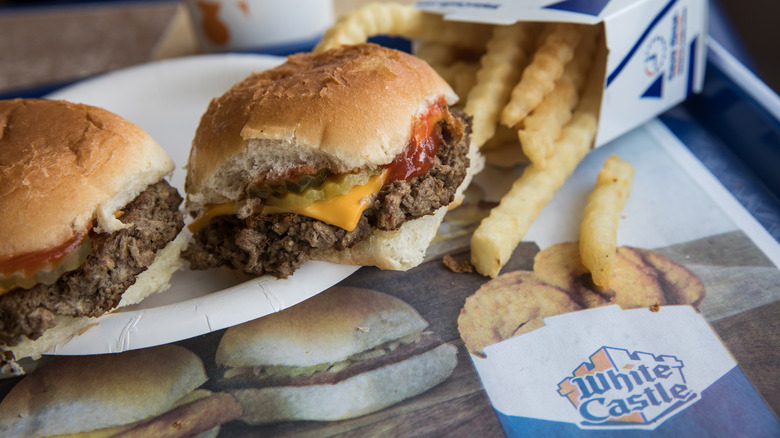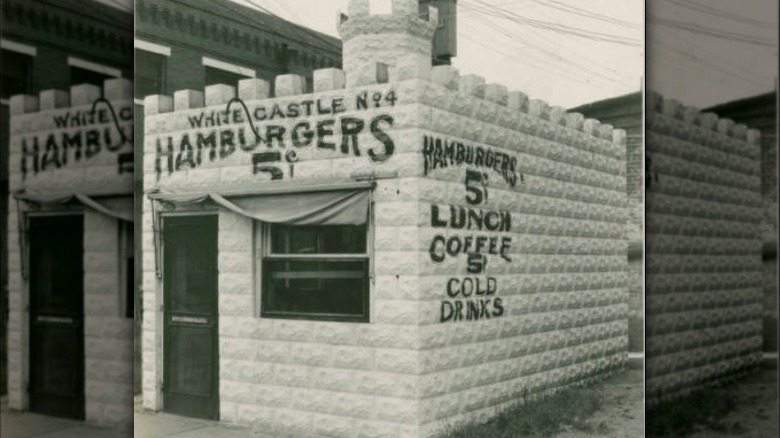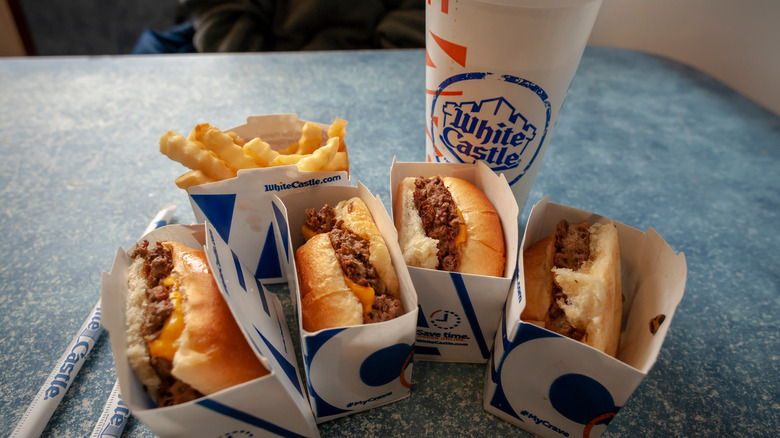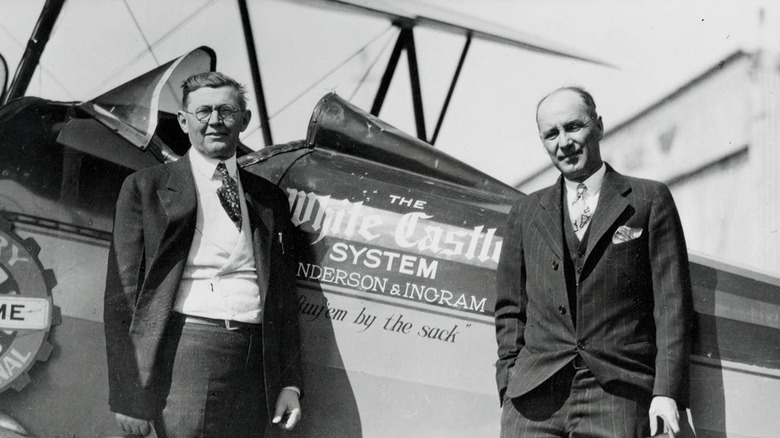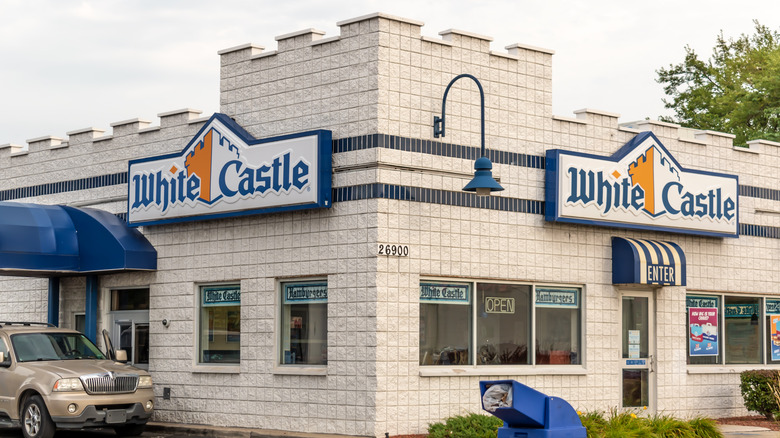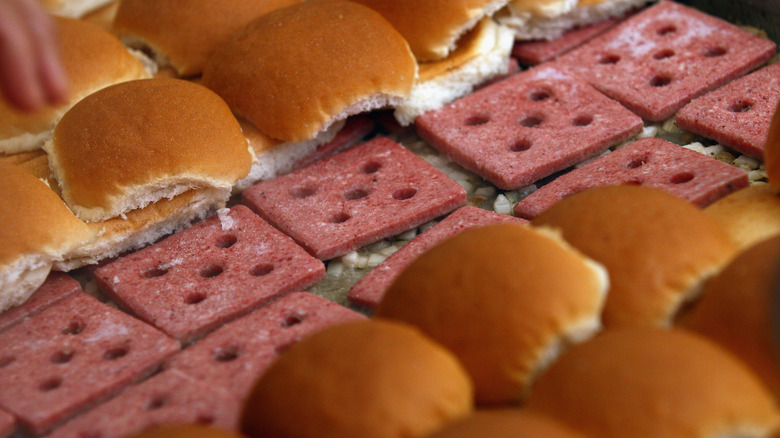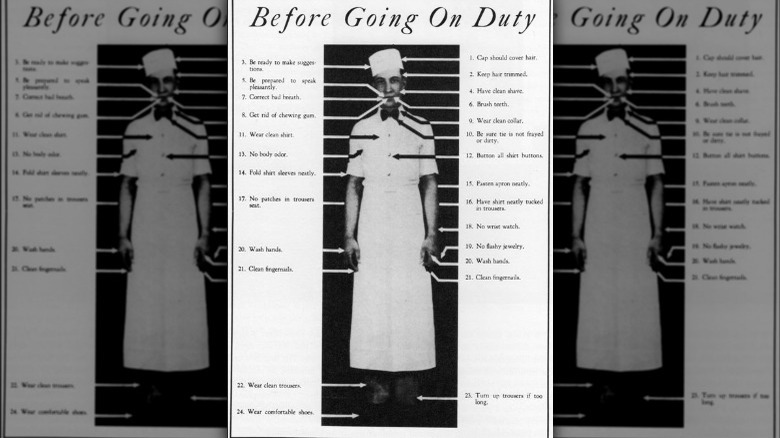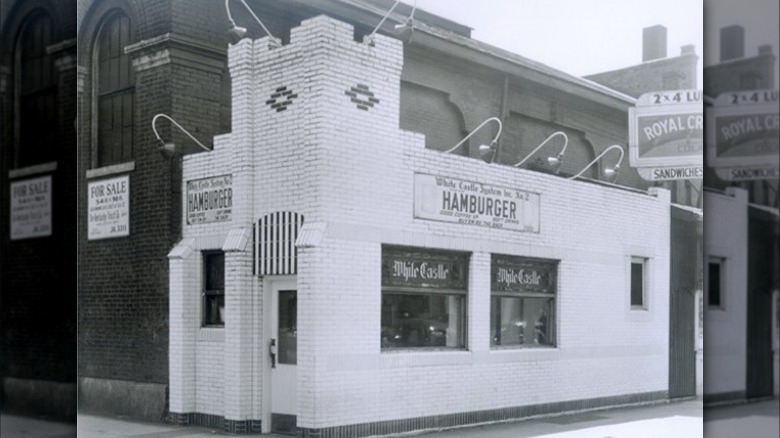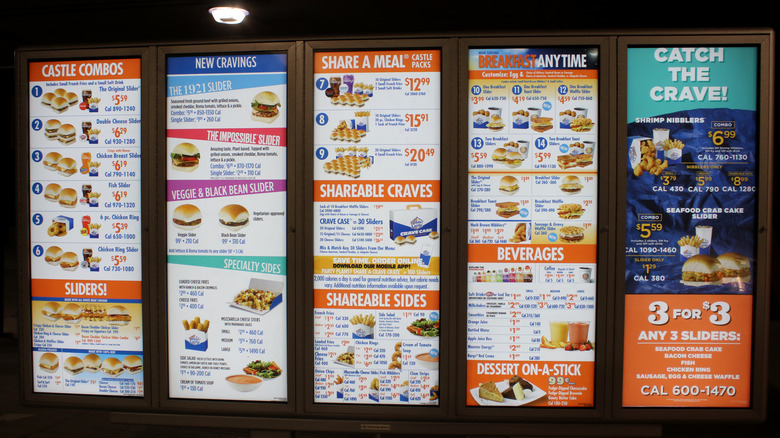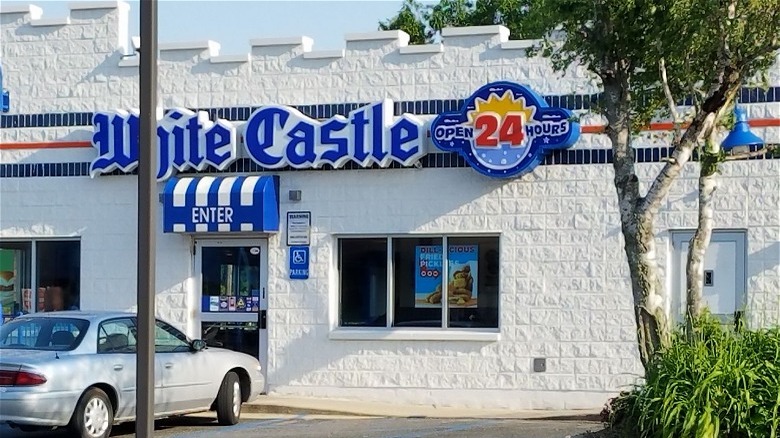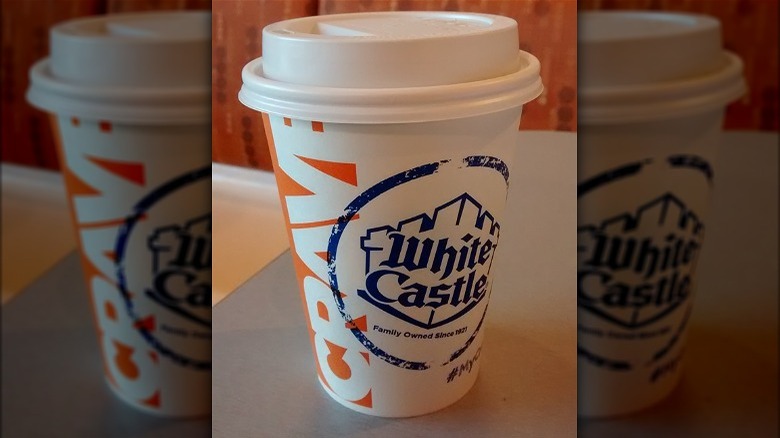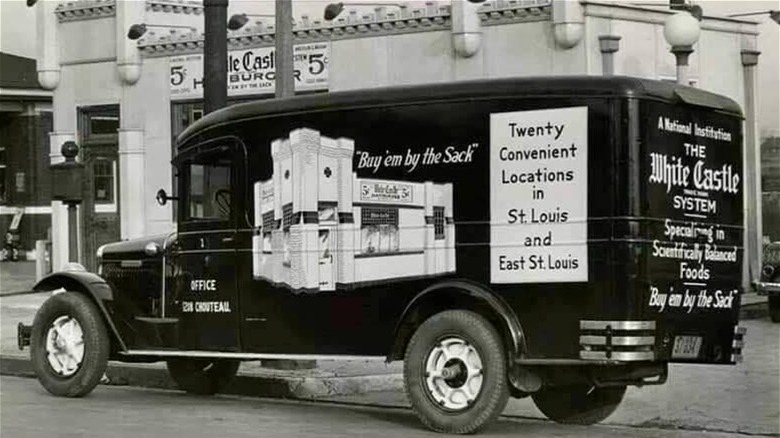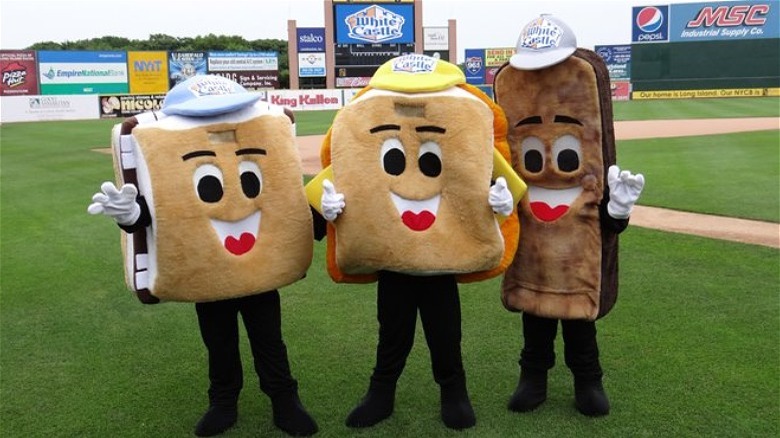What It Was Really Like To Eat At The First White Castle
Let's be honest, White Castle is one of the greatest fast food restaurants of all time. Yes, even though McDonald's fries are the perfect mixture of fluffy and crunchy, White Castle walked so other big fast food brands could run. Recognized as the first fast food burger chain in the world, its abilities have no bounds. White Castle holds many firsts in the world: first coupons, first carry-out concept, first fast food Impossible burger, and countless others (via White Castle). It's the most influential burger to rock the fast food industry and its legacy is one that will survive long after the last pieces of styrofoam break down in landfills.
White Castles everywhere get a bad rap for being just cheap, late-night stoner food thanks in part to the movie "Harold & Kumar Go To White Castle." To that we add a correction –– it's delicious, cheap, late-night and early-morning food. One of the best things about White Castle is its bite-sized and crave-able sliders that can be ingested by the handful or bagful, depending on how intense the munchies are.
White Castle opened in 1921 as a revolutionary institution that changed how consumers perceived fast food. It took everything that people knew about restaurants, flipped it on the grill, and loaded it with onions. That being said, the first White Castle, in many ways, was very different from today's version.
The first restaurant that opened wasn't technically a White Castle
There are approximately 368 White Castle restaurants in 14 different states around the U.S., not including international branches (via ScrapeHero). The magic began over 100 years ago, when White Castle was founded in 1921 in Wichita, Kansas, by Edgar Waldo "Billy" Ingram and Walter Anderson (via Restaurant News). Anderson was the original mastermind behind the idea of the fast food hamburger chain. He had been operating various food stands, including one that opened in an old streetcar, from 1916 until he conceptualized the first White Castle stand (per America Comes Alive!).
Between 1916 and 1920, Anderson opened three burger stands but wanted to grow the concept even further. However, it wasn't until 1921 that Anderson and Ingram partnered together to open a new, fourth restaurant under the official White Castle name. It wasn't even considered a formal company until 1924 when "White Castle System of Eating Houses" was incorporated (via Cook's Info). So, if we are being very technical, the original three White Castles weren't a part of the official restaurant chain until the fourth stand came about. It's confusing, similar to how the first "Star Wars" movie is technically the fourth in the franchise.
White Castle sliders weren't any cheaper back in the day
We assume that, because of inflation, everything back in the day was cheaper and more affordable. For the price of a gallon of gas in today's money, you could probably buy a week's worth of groceries in the early 20th century. However, there are surprisingly some things that were more expensive in the 1920s than they would be today.
When White Castle opened in 1921, a White Castle burger cost 5 cents (via Cook's Info). When White Castle started rolling out the first fast food newspaper coupons, you could purchase five slider burgers for 10 cents. According to a coupon listed in Consumerist, by 1952, a sack of five sliders would cost you around 24 cents. However, an individual slider in 1980 cost 26 cents and skyrocketed in price to 39 cents a slider by 1991 (per Chicago Tribune).
As of 2022, an individual original White Castle slider costs around 72 cents. According to the U.S. Inflation Calculator, 5 cents in 1921 equates to 83 cents in 2022 money. Surprisingly, burgers were more expensive in 1921 than they were at the time of publication if you adjust for inflation (via Fast Food Menu Prices). Now, if only that same rationale applied to gas prices.
You might have seen the founders flipping burgers
As previously stated, Anderson and Ingram were the business partners that started the White Castle phenomenon. On the official White Castle website, it lists Ingram as the Original Craver and founder. That being said, Anderson was the mastermind behind the White Castle hamburger invention itself, while Ingram was the one that formulated the pure and progressive image that White Castle exuded (per Sauver).
Ingram never imagined ending up in the fast food business, originally working various jobs and eventually becoming an insurance agent. Ingram met Anderson on the job when he already owned and operated three slider stands. The two men decided to partner up to open the fourth, which was the first official White Castle. Eventually, he left his insurance job to focus on the business side of White Castle full-time, while Anderson would be seen flipping burgers in the back (via Columbus Business First).
When Ingram wanted to move the company headquarters to Columbus, Ohio, in the 1930s, Ingram bought out Anderson from his partnership. Instead of picking a different fast food venture, Anderson decided to make waves in the aviation industry. The move to Columbus was prompted by Ingram's desire to be close to the Porcelain Steel Building Company, which helped construct supplies for White Castle locations. Ingram died in 1966 and was succeeded by his son and eventually other family members, making White Castle a true family business.
It's named White Castle for a weird reason
The White Castle building itself is about as recognizable as the food inside is. The gleaming white castle exterior holds something more precious than the most esteemed of royalty or the brightest of diamonds. In this case, the sliders are the crown jewel in White Castle's crown.
Anderson had been flipping burgers for years, it wasn't until Ingram partnered with him that the White Castle brand came to fruition. Around the time White Castle opened, journalists were beginning to take deep dives into big corporations and their practices. Upton Sinclair's hit exposé highlighting the unsanitary nature of meatpacking plants called "The Jungle" had recently been released in 1906 and consumers were still hesitant (via Columbus Business First).
In order to combat consumers' fears of shady beef practices, Ingram designed White Castles to have porcelain and stainless steel fixtures to highlight the cleanliness that the company practiced and preached. The name White Castle was meant to no-to-subtly exude cleanliness and strength in order to combat the negative image portrayed by the media that hamburger meat was unsanitary. To show complete transparency, the partners wanted to have an open layout so customers were able to see workers grinding the fresh hamburger used for its famous sliders (via Cook's Info).
White Castle's burgers originally had no holes
There aren't many things that are more iconic than the famous White Castle slider, unless you count what's under the bun. White Castle has had the signature domino-style five holes punched into every beef patty since what feels like the beginning of time. It's the brand's signature yet semi-secretive trademark that only the real fans truly know about. But unbeknownst to us, the famous White Castle holes were not around until over 30 years after the first store opened.
White Castle Vice President Jamie Richardson sat down with Thrillist to answer the question: why do the burgers have holes? It wasn't a happy accident but instead a strategy that had a key purpose in ensuring the slider's uniformity. It was conceptualized in 1954, not by one of the founders, but by a back-of-the-house burger flipper in Cincinnati, Ohio. Earl Howell started putting holes in the burgers to expedite cooking and it eventually became a part of White Castle's standard practice.
It works so well because the burgers today are steamed as opposed to grilled like it was done back in the day (via Medium). Steaming eliminates the need for flipping and allows the patties to cook faster. Placing holes in the burger not only pushes the onion flavor more into the patty but also gives the bun a great, umami-rich flavor as well. White Castle even has its own patented machine to make burger flipping efficient and scientific (via Thrillist).
Employees had a strict dress code
There was once a time when fast food workers didn't have to dress in their finest non-slip dress Crocs or fast food-branded hats. No, when the first White Castle opened, its employees were dressed to the nines like they were serving at a fine dining establishment instead of a fast food burger stand.
Firstly, Ingram was very particular about the demographics of the employees. He hired fit and healthy-looking service workers to reflect the healthy lifestyle he was trying to associate with White Castle sliders. He even paid for a study with the University of Minnesota to prove that White Castle sliders could be a part of a well-balanced diet. There was a dark side to this: Prior to World War II, Ingram had a policy that he only hired white men to work in the stores. However, when he lost his workforce to higher-paying jobs or the military, he began to hire women and people of color (via Cooks Inc.).
Ingram was also very exacting about the cleanliness of his employees, as seen in this archived White Castle appearance chart. White Castle even had its own patented white paper hats made from a custom hat-folding machine that all service workers had to wear (via Richland Source). Today, White Castle employees don't have to dress in their Sunday best, but that doesn't mean they sacrifice style. In 2021, White Castle collaborated with the brand Telfar, to create a stylish modern-day uniform (per Vogue).
There are no restaurants left in its home state of Kansas
Since we have unofficially become White Castle experts, we know that White Castle was founded in Wichita, Kansas. Around 10 years later though, Ingram moved the headquarters to Columbus, Ohio, taking the White Castle heart and soul out of Kansas. Despite its humble beginning there, it's surprising to realize that there are no White Castles anywhere in Kansas as of 2022.
White Castle Vice President Jamie Richardson discussed with Kansas City Mag the reason why there were no longer White Castles in Kansas. He explained that a White Castle employee and good friend of Ingram's, Jimmie King, moved to Columbus near the new headquarters. King wasn't a fan of Ohio and wanted to return to Kansas. Ingram explained to him that he would sell King the White Castles in Kansas and let him open up his own restaurant in their place. King agreed, opened King's-X, and White Castles have not returned to Kansas since.
Overall, White Castle is pretty picky about where and in which states its restaurants open in, probably because the stores continue to be company-owned and run (via Forbes). Surprisingly, according to ScrapeHero, Illinois has the most White Castles, then Indiana, and of course, Ohio. Most of the locations are in the Midwest, but there may come a day when White Castle ends the gentleman's pact and moves back to Kansas.
White Castle's original menu items are still around
The White Castle menu, like most fast food menus, can be an overwhelming site to take in, especially for someone with drive-thru anxiety. When White Castle first opened up, it had a pretty limited menu –– nickel hamburgers, ice-cold Coca-Cola, pie, and piping-hot coffee (via Whiting-Robertsdale Historical Society). You can still enjoy White Castle's original menu items but with a few different twists here and there.
White Castle still runs each restaurant like a well-oiled machine, putting an emphasis on consistency inspired by the efficiency of Henry Ford's assembly line (per Saveur). White Castle was also the first restaurant to sell over a billion burgers, predating even the biggest of fast food giants like McDonald's (per America Comes Alive!). With that in mind, it makes sense that the original square slider topped with onions and pickles still exists on the menu today; White Castle even launched a commemorative 1921 slider in 2021 with all the same tastes and flavors as the original (via PR Newswire).
White Castle tends to be a creature of habit and likes to stick to the classics. Cheeseburgers weren't even on the menu until 1962 –– the first new item added since White Castle opened. The classic cup of coffee still reigns on the menu but the traditional slice of pie got a modern makeover with White Castle's dessert-on-a-stick creation, which is arguably better.
It was open 24 hours a day
In 2022, White Castle announced that the chain restaurant had sold more than 6 billion sliders. 20% of the slider's sales had occurred within the last three years (per PR Newsire). It's hard to believe that any fast food chain could achieve those numbers. Perhaps their handheld size or delicious nature could contribute to the billions of sliders consumed, but another factor could be the endless production of sliders 24 hours a day, seven days a week.
Since the first White Castle restaurant, the store has been open 24 hours a day. From early on in the business, Ingram believed "that everybody deserved a night out –– to be able to get hot and tasty food at any time of day." It was all about convenience that wouldn't break the bank, appealing to partiers, stoners, and third-shift workers (per Dayton.com).
Sure, it makes the perfect late-night munchie food — the reliable option when the thought of gas station sushi makes your stomach churn. Sadly, not every White Castle location now is open 24/7 and some are only open from 8 a.m. to 3 p.m. seven days a week. That being said, aside from Christmas Day, you can always count on White Castle to be there waiting for you at the end of a long night or morning (via Clinicinus).
The coffee was a highly loved menu item
Coffee is one of the greatest gifts that the world can give us. It was actually one of White Castle's most popular menu items when it first opened. According to Reference for Business, White Castle pioneered many of the practices that go into how fast food chains dish out coffee today. The company took many measures to provide the highest quality coffee around, even going as far as to install special equipment such as a hydrometer. Per an archived Ohio History Connection advertisement, the chain sold over 15 million cups of coffee in 1941.
According to Cook's Info, White Castle was ahead of its time in its use of dishwashers in its stands and restaurants. Ingram even went as far as to design a specialized coffee mug with slots on the bottom rim of the cup to keep gunky and dirty water from accumulating when washed. Coffee may not be as big of a staple at White Castle as it was in the beginning, but you always know it's going to be piping hot and delicious every time. White Castle hasn't jumped on the fancy flavored coffee train yet with pumpkin-spiced anything. It sticks to the classics –– a signature hot coffee with all the classic taste we know and reminisce about.
The Buy 'em by the Sack phrase was the original slogan
White Castle was the first fast food restaurant to streamline take-out style fast food meals, specifically with its stackable slider boxes (via Restaurant News). It has made a name for itself with its stackable sliders that can be bought by the sackful. It was even the basis for the very first White Castle slogan that became instantly iconic.
"Buy 'em by the Sack" was originally created in 1916, before the first official White Castle store was founded. According to the book "Selling 'em by the Sack," Ingram wanted to truly emphasize not only the slider's petite size but also its incredibly cheap price with the slogan. The burgers really came in sacks, too. This caused problems when ordering a bunch for takeout, as the bottom sliders would get smushed. This problem was fixed when White Castle began selling its sliders in individual cardboard boxes that stacked neatly inside the sacks. In 2003, White Castle changed its catchphrase to "It's What You Crave" — a perfect pairing for its crave-able brand and hamburgers (via Cook's Info).
There was no restaurant mascot
Fast food mascots, while recognizable, are inherently slightly terrifying (perhaps we are just projecting here). White Castle is one of the few fast food joints that doesn't have a mascot. In addition to well-groomed employees, Ingram wanted to not necessarily have a mascot but a spokeswoman who would appeal to his target audience. He wanted the quintessential Betty Crocker figure, someone that would appeal to the classic housewife stereotype in order to reach middle-class women and mothers who would pick up White Castle for dinner (via Columbus Business First).
The fictional spokeswoman named "Julia Joyce" was featured in numerous advertisements. She would also travel to various White Castles and women's clubs to bring snacks, products, and coupons to help spotlight the takeout and catering services offered. In fact, the real woman behind the fictional Julia Joyce was Ella Louise Angel, a secretary turned White Castle public relations officer (via Cook's Info).
Even after the housewife spokeswoman dies off, White Castle never officially adopted a mascot. Instead of a person dressed in a full-body slider costume, people on Twitter have instead seen a Crave Crew member with a hamburger slider for a head, which looks more like an extra in a horror video game than a mascot. We give it four stars for creativity and an eight for shock value.
